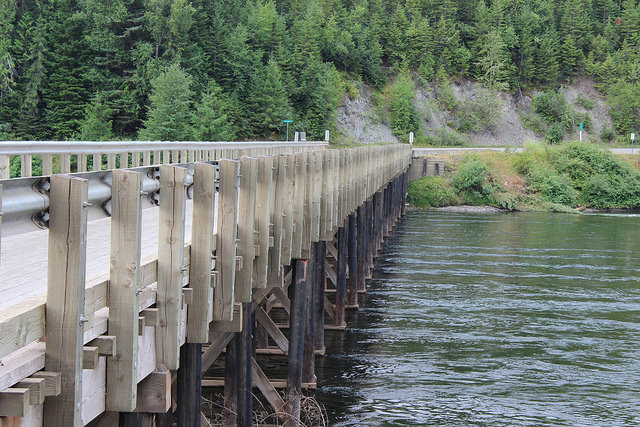The drinking water for hundreds of communities and thousands of kilometres of waterways are at risk from tailings ponds in British Columbia.
The Globe and Mail reports, “The [B.C. First Nations Energy and Mining Council] has, for the first time, mapped out the 35 active mine tailings ponds [on 48 key watersheds] in the northern half of the province and traced the potential paths of contaminants from dam failures at any of those sites. The survey found that 80 per cent of the chinook and sockeye salmon in the region are either downstream from a tailings facility or would migrate up a river that could be contaminated. It also concluded that there are risks to the drinking water of 33 First Nations and 208 other communities, including Prince George, Smithers and Terrace.”
The Vancouver Sun says the report — Uncertainty Upstream: Potential Threats from Tailings Facility Failures in Northern British Columbia — further specifies, “Computer-generated geographic data shows a total of 3,275 kilometres of waterways are immediately downstream of the 35 mine-waste storage facilities, and 5,403 km lie in watersheds further downstream where the contaminants could eventually reach.”
The risk is very real: “In January, an expert panel report on the Mount Polley incident concluded that, based on past performance, British Columbia can expect to see two failures of tailings ponds every 10 years — a not-insignificant risk that spurred calls for an overhaul of the province’s regulatory regime for the mining industry.”
And the situation is set to worsen: “British Columbia’s north is poised for an explosion of new-mine development. The provincial government has pushed for the creation of mines as part of its jobs plan, building a new power transmission line to encourage industrial development in the northwest and promising to cut red tape for mine permits.” In this September 2011 campaign blog we noted that British Columbia premier Christy Clark and her Liberal government are committed to opening eight new mines and expanding another nine in the province.
In terms of a timeline, there are at least three key dates to keep in mind. In June, the results from an inspection of the 123 tailings pond dams in the province is due. In early July, the provincial government will decide if the Mount Polley mine (which released 10 billion litres of contaminated water and 4.5 million cubic metres of metals-laden fine sand into Hazeltine Creek, Polley Lake and Quesnel Lake last August) will be allowed to restart. The Council of Canadians has actively opposed the reopening of this mine. And sometime this summer, the provincial government will also issue a report on mining regulations in the province.
In February, Council of Canadians chairperson Maude Barlow wrote to Premier Clark to ask her to rethink Bill 18, her government’s new Water Sustainability Act. That’s because the Act does not recognize the human right to water. Barlow wrote, “In July 2010, the United Nations General Assembly recognized the human right to water and sanitation. As a result, there are now three obligations that governments must follow: the obligation to respect, protect and fulfill. We regret that Bill 18 does not explicitly recognize this right and we believe it also fails to meet these obligations.”
The obligation to protect means, in this instance, that the provincial government is obliged to prevent third parties like mining companies from interfering with the enjoyment of the human right to water. A mining agenda that puts at risk the drinking water for 208 communities and 33 First Nations clearly violates that obligation.
We have also highlighted that the right to water is being further put at risk by the Liquefied Natural Gas (LNG) agenda pursued by the Clark government. The gas needed for just five of the proposed LNG terminals in the province would require an estimated 582 billion litres of water from British Columbia’s rivers, lakes and streams. Those five LNG terminals could also require an estimated 39,000 new wells by 2040, the majority of which would likely be fracked.
Photo: BC Gov Photos/flickr



